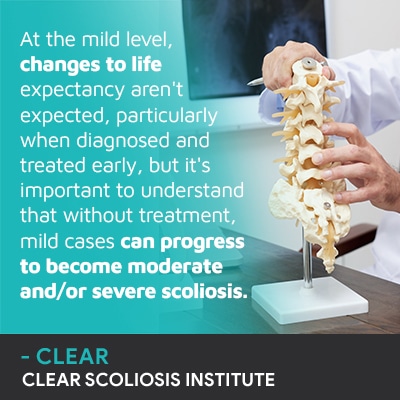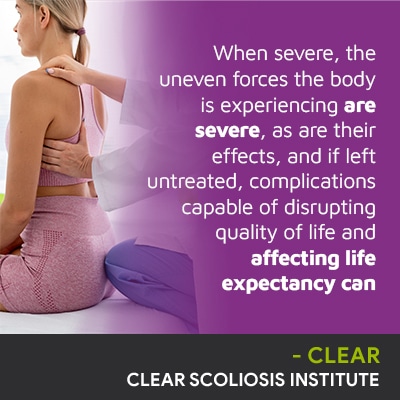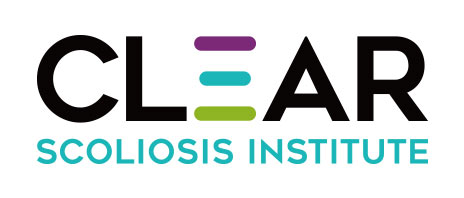
Scoliosis can range from mild scoliosis to moderate scoliosis and severe scoliosis; a lower life expectancy isn't considered a common effect of the condition, but as a progressive condition, if scoliosis is left untreated, and/or is particularly severe, complications can develop with the potential to impact a patient's quality of life and life expectancy.
Scoliosis is a spinal condition that can affect the body in a number of ways. When it comes to life expectancy, scoliosis is more likely to affect it indirectly: due to a complication of particularly severe and/or untreated scoliosis. Scoliosis can be highly treatable.
As condition severity is an important factor that shapes a patient's scoliosis symptoms, let's explore the different severity levels.
When scoliosis is first diagnosed, it's comprehensively assessed based on a number of important factors; these variables shape the customization of treatment plans.
Scoliosis causes an unnatural lateral spinal curvature to develop that also rotates, and as a progressive condition that's triggered by growth, the nature of mild cases is to become more severe, particularly if proactive efforts aren't made with treatment.
A measurement known as Cobb angle determines condition severity, and it's taken during X-ray; a scoliosis X-ray is needed to officially diagnose scoliosis because the Cobb angle measurement has to be at least 10 degrees, and there has to be rotation present to be considered a true scoliosis.
Being diagnosed with mild scoliosis means the unnatural spinal curvature is small, and in many cases, is highly treatable at this point, but it can change quickly, particularly in childhood scoliosis; progression is triggered by growth.
Smaller curves are simpler to treat, but they are also harder to diagnose because mild cases have mild symptoms, not always noticeable to the average person.
If scoliosis is diagnosed while mild, this can be highly beneficial, but only to patients who commit to a proactive conservative treatment approach.
In many cases of childhood scoliosis, the earliest signs are uneven shoulders and uneven hips; the main symptoms of childhood scoliosis involve postural changes caused by the introduction of uneven forces to the spine, its surroundings, and the body as a whole.
A spine that's misaligned means a body that's out of balance.

Most patients are diagnosed with moderate scoliosis because the signs of mild scoliosis can be subtle, and it's not until conditions progress into the moderate level that many symptoms of scoliosis become noticeable enough to lead to assessment and diagnosis.
A significant challenge to early detection of childhood scoliosis is the lack of pain. Scoliosis becomes compressive once growth has stopped: compression is uneven pressure.
It's compression of the spine and its surroundings that causes back, muscle, and nerve pain, and pain is the most common symptom of adult scoliosis.
The postural changes associated with mild cases become more overt as progression occurs.
In addition to uneven shoulders, shoulder blades, and hips, a rib cage arch can develop, and arms and legs can hang differently.
When moderate, the signs are more overt, and changes to movement are also common, particularly if moderate scoliosis is progressing into the severe classification.
Moderate scoliosis is also not commonly associated with a lower life expectancy, but if moderate scoliosis is left untreated and becomes severe, this is when potential complications can occur.
Severe scoliosis patients have a Cobb angle measurement of 40+ degrees, and the more severe a scoliosis is, the more likely continued progression is.
In severe cases, digestive issues, breathing problems, and pulmonary function can be disrupted.
At the severe level, in addition to postural changes, changes to movement are also noticeable as balance, coordination, and gait are disrupted.
The more severe a condition is, the more noticeably it will affect posture and movement, and in adults for whom scoliosis is compressive, back and nerve pain can be debilitating.

Severe scoliosis can cause digestive issues as the unnaturally-curved spine can cause compression of the esophagus, stomach, and intestines.
The postural changes and compression associated with severe scoliosis can mean less space for certain organs to function optimally within, and this can lead to acid reflux, constipation, and irritable bowel syndrome (IBS).
When there are digestive issues, the body's ability to absorb important nutrients can be impacted, and this can affect a person's overall health; if left unaddressed, malnutrition can become a contributing factor to a lower life expectancy.
Lung impairment and breathing problems can also develop with severe and/or atypical cases as changes to the rib cage can affect the space available for the lungs.
In addition to the different severity levels of scoliosis that impact symptoms and life expectancy, there are also atypical condition types that are more closely associated with a lower life expectancy.
Most cases of scoliosis are classified as idiopathic scoliosis, meaning no known cause, and this accounts for a staggering 80 percent of known cases, and in these condition types, spinal curves bend to the right, away from the heart: known as dextroscoliosis.
In atypical cases that can be particularly severe, curves can bend to the left, towards the heart, so when a left-bending curvature of the spine is seen on an X-ray, it's clear that there is a known cause and that the scoliosis isn't a typical case.
When a curve bends to the left, towards the heart, it can cause cardiac issues if the heart is being compressed.
While most cases involve idiopathic scoliosis, the remaining 20 percent have known causes: congenital scoliosis, degenerative scoliosis, and neuromuscular scoliosis.
Of all the condition types, neuromuscular scoliosis can be the most severe and closely associated with a lower life expectancy, particularly in cases involving respiratory and cardiac complications.
Neuromuscular scoliosis is caused by a serious neuromuscular condition such as spina bifida, muscular dystrophy, and cerebral palsy, and as the scoliosis develops as a related complication, it can be severe.
Neuromuscular scoliosis involves a disruption in communication between the brain, the spine, the muscles and connective tissues that support the spine.
Because there is a larger neuromuscular condition causing the scoliosis, the larger condition has to be the focus of treatment, and these are often severe cases with some patients becoming unable to walk on their own and confined to a wheelchair.
So of the different types of scoliosis, neuromuscular scoliosis is commonly the most severe, the most likely to cause complications capable of lowering life expectancy.
Scoliosis can cause a number of different effects. Although scoliosis is a spinal condition, the uneven forces it introduces to the body can be damaging in different ways.
An unnatural sideways curvature of the spine that also twists is problematic and can become severe, especially if left untreated, but in most cases, it's highly treatable and not considered a life threatening condition.
While surgical intervention is always an option for scoliosis patients, spinal fusion surgery comes with some serious potential risks and complications, capable of impacting a patient's longevity: infection, excessive blood loss, nerve damage, and/or an adverse reaction to hardware used.
Of the different severity levels and types of scoliosis, very severe scoliosis and atypical types like neuromuscular scoliosis are the most capable of affecting life expectancy.
There are never treatment guarantees, and many factors shape how a patient responds to treatment, but in most cases of an abnormal curvature of the spine that's treated proactively, improvements can be made without the need for a risky surgical procedure.
The best way to minimize the effects of scoliosis and prevent life-threatening complications is to be proactive with treatment: start it immediately following a diagnosis and commit to a non-surgical conservative treatment approach.
Particularly with scoliosis diagnosed early and treated proactively, there are fewer limits to what conservative treatment options can achieve.
As a progressive spinal condition, the nature of scoliosis is to become more severe, so scoliosis cases that are left untreated can cause complications that a proactive treatment approach could have helped avoid.
Here at the CLEAR Scoliosis Institute, scoliosis is treated proactively and conservatively with the goal of preventing progression, the need for invasive spinal surgery, and the potential for life-threatening complications.

CLEAR provides a unique and innovative way of understanding scoliosis. Sign up to receive facts and information you won’t find anywhere else.
